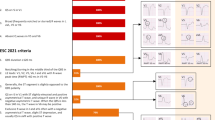Abstract
Aims
We evaluate the incidence of epicardial lead failure and try to identify risk factors in patients with congenital heart disease.
Methods
All patients with a congenital heart defect and an epicardial pacing system, implanted within a timeframe of 25 years, were included in this study. Patients’ medical records and lead data were reviewed. Lead failure was defined as the primary endpoint.
Results
In total 198 active epicardial leads (atrial 40, ventricular 158) were implanted in 93 patients (median age at implantation 4.4 years (range 0–58.6)). During a total follow-up of 1235 lead-years, 29 lead failures (14.6%, 4 atrial, 25 ventricular) were documented in 22 patients (23.7%). Lead failure occurred at a median time period of 4.8 years (range 1.2–24.1) after implantation. Five-year freedom of lead failure was 88%. The only independent predictor for lead failure was the age at implantation (HR 0.44; 95%CI 0.20–0.97, p = 0.04), other characteristics failed to predict lead failure. Sudden cardiac death occurred in four patients (4.3%), in one a lead failure was documented.
Conclusion
A high incidence of epicardial lead failures is found in patients with congenital heart disease. Unfortunately, it is difficult to predict this potentially life-threatening complication.


Similar content being viewed by others
References
Fortescue EB, Berul CI, Cecchin F, et al. Comparison of modern steroid-eluting epicardial and thin transvenous pacemaker leads in pediatric and congenital heart disease patients. J Interv Card Electrophysiol. 2005;14:27–36.
Beaufort-Krol GC, Mulder H, Nagelkerke D, et al. Comparison of longevity, pacing, and sensing characteristics of steroid-eluting epicardial versus conventional endocardial pacing leads in children. J Thorac Cardiovasc Surg. 1999;117:523–8.
Ector B, Willems R, Heidbuchel H, et al. Epicardial pacing: a single-centre study on 321 leads in 138 patients. Acta Cardiol. 2006;61:343–51.
Cohen MI, Bush DM, Vetter VL, et al. Permanent epicardial pacing in pediatric patients: seventeen years of experience and 1200 outpatient visits. Circulation. 2001;103:2585–90.
Silvetti MS, Drago F, Grutter G, et al. Twenty years of paediatric cardiac pacing: 515 pacemakers and 480 leads implanted in 292 patients. Europace. 2006;8:530–6.
Murayama H, Maeda M, Sakurai H, et al. Predictors affecting durability of epicardial pacemaker leads in pediatric patients. J Thorac Cardiovasc Surg. 2008;135:361–6.
ten Udink CF, Breur J, Boramanand N, et al. Endocardial and epicardial steroid lead pacing in the neonatal and paediatric age group. Heart. 2002;88:392–6.
Tomaske M, Gerritse B, Kretzers L, et al. A 12-year experience of bipolar steroid-eluting epicardial pacing leads in children. Ann Thorac Surg. 2008;85:1704–11.
Sachweh JS, Vazquez-Jimenez JF, Schondube FA, et al. Twenty years experience with pediatric pacing: epicardial and transvenous stimulation. Eur J Cardiothorac Surg. 2000;17:455–61.
Horenstein MS, Hakimi M, Walters III H, et al. Chronic performance of steroid-eluting epicardial leads in a growing pediatric population: a 10-year comparison. Pacing Clin Electrophysiol. 2003;26:1467–71.
Fortescue EB, Berul CI, Cecchin F, et al. Patient, procedural, and hardware factors associated with pacemaker lead failures in pediatrics and congenital heart disease. Heart Rhythm. 2004;1:150–9.
Cutler NG, Karpawich PP, Cavitt D, et al. Steroid-eluting epicardial pacing electrodes: six year experience of pacing thresholds in a growing pediatric population. Pacing Clin Electrophysiol. 1997;20:2943–8.
Crossley GH, Brinker JA, Reynolds D, et al. Steroid elution improves the stimulation threshold in an active-fixation atrial permanent pacing lead. A randomized, controlled study. Model 4068 Investigators. Circulation. 1995;92:2935–9.
Johns JA, Fish FA, Burger JD, et al. Steroid-eluting epicardial pacing leads in pediatric patients: encouraging early results. J Am Coll Cardiol. 1992;20:395–401.
Author information
Authors and Affiliations
Corresponding author
Rights and permissions
About this article
Cite this article
Post, M.C., Budts, W., Van de Bruaene, A. et al. Failure of epicardial pacing leads in congenital heart disease: not uncommon and difficult to predict. Neth Heart J 19, 331–335 (2011). https://doi.org/10.1007/s12471-011-0158-5
Published:
Issue Date:
DOI: https://doi.org/10.1007/s12471-011-0158-5




